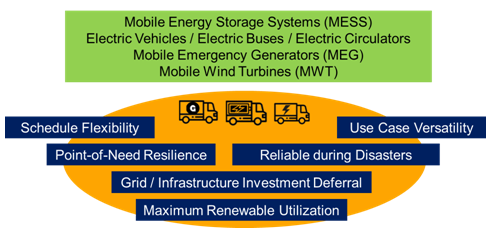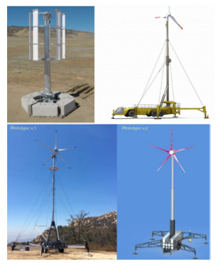Mobility-As-A-Service for Energy Resilience in Smart Cities
Written by Payman Dehghanian
With the advent of more frequent and higher-intensity extremes, smart cities face numerous challenges when it comes to energy delivery during disasters. In facing a disaster, either natural or man-made, the importance of maintaining a reliable and sustainable energy supply cannot be overstated, as it is critical for ensuring the functionality of essential services such as hospitals, emergency services, and communication networks. One of the major challenges in energy delivery during natural disasters is the damage caused to energy infrastructure resulting in widespread power outages. This can have severe consequences, especially if the outage lasts for an extended period, as it can lead to disruptions in food and water supply, transportation, and other essential services, quickly turning into a national security concern. Maintaining a reliable and sustainable energy supply is crucial for smart cities during natural disasters. Effective energy delivery systems, including backup power sources, are critical in maintaining the functionality of essential services and ensuring the resilience of smart cities when facing extremes.
Existing Practice and Vulnerabilities in Energy Service Restoration Amid Disasters
In practice, power restoration following an extreme event is commonly approached through (i) maintenance and repair activities of the damaged electrical infrastructure by repair crews, (ii) switching actions and electrical network topological reconfiguration to alter the electricity flows for faster electricity service restoration, and (iii) deployment and use of stationary emergency generators (SEGs) installed at critical load facilities as a backup energy source during emergencies [1]. During a disaster, the repair process may take days, leaving thousands of people without electricity until the damaged equipment is fully repaired and back online. The duration of the repair process can vary depending on the geographical area (rural or urban), nature and intensity of extreme events, human resource and repair crew availability, and disruptions in other interdependent critical infrastructures, such as communication and transportation systems. The prolonged electricity outage due to lengthy repair processes may result in dramatic consequences for people and every aspect of the electrified economy [2]. Although the second practice, that is, electrical network topology control, can be performed in an automated manner, this practice requires the installation of switching infrastructure across the power distribution system to enable network topological reconfiguration via opening/closing of the switches. While many power distribution systems in practice may not be equipped with the required number of switches, making the energy system fully re-configurable through the installation of switching infrastructure is an expensive option that needs to be incorporated in expansion planning studies by the system planners [3]. Moreover, the switching infrastructure could be also damaged due to extreme incidents or could become unavailable due to poor maintenance of equipment over time. Unlike the first and second approaches—which contribute to service restoration through grid-scale re-connection or reconfiguration—backup SEGs are employed to supply power locally to particular services following extremes, such as providing electricity for hospitals to rescue injuries or energy-intensive flood water pumping facilities. The contribution of backup SEGs is in general limited. Furthermore, SEGs produce electricity by consuming diesel fuels, and their effectiveness will be hindered by potential disruptions in the fuel supply chain and the transportation sector during extreme events. Disruptive technologies are needed that can aid in (i) facilitating a faster energy system restoration and its sustained operation during extreme events and (ii) supporting the energy-intensive facilities (e.g., flood water pumping), as well as the electricity delivery to mission-critical systems and emergency services until the system is returned to normal operations.
Mobile Power Sources (MPSs) vs. the Traditional Practice
Mobile power source (MPSs) emergency service vehicles, the mobility of which could be harnessed during extreme events to enable spatiotemporal flexibility exchange and enhance the energy system resilience. More specifically, spatiotemporal flexibility refers to the feature of MPSs being able to travel across space and time, that is, to deliver power and energy via the transportation system during the restoration process [4]. MPSs can be one of the most effective response and recovery resources when sustained damage leads to prolonged electric service outages in the cities. In urban areas, it generally takes several hours for repair crews to repair damaged electrical infrastructure, while they might spend days in rural areas until the damaged infrastructure is fixed. In coordination with the repair schedules, the service restoration process can be accelerated by assigning MPSs to serve the system’s critical load points. Since MPSs are emergency service vehicles, they should be dispatched to required areas through the transportation system [5]. The node-to-node connectivity status of the transportation system should be carefully taken into account when deciding on the joint assignment of MPSs and repair crews for energy service restoration. This is because extreme events may disrupt the transportation sector (i.e., travel route availability), which impacts the decisions on routing and scheduling of MPSs and repair crews during the restoration process.
While MPSs can accelerate the response and recovery in power distribution systems in the face of extreme events, their potential for delivering resilience services has remained largely untapped and they are currently not well utilized in practice. For example, before Hurricane Sandy struck [1], 400 industrial-size MPSs were prepared by the Federal Emergency Management Agency (FEMA), but only a portion of them was providing power even three days after Sandy made its landfall. Holistic strategies enhancing the efficiency of MPSs utilization can render faster restoration and augmented resilience.
Figure 1: The mobility of MPSs can be harnessed for spatiotemporal flexibility exchange and effective response and recovery during disasters.
Emerging MPS Technologies
During the past several years, disruptive MPS technologies have been found to be key enablers for outage management following disasters.
- Mobile Emergency Generators (MEGs) are critical flexibility resources for fast electric service restoration across the power distribution systems, especially when customers lose access to the main grid. MEGs are truck-mounted power generators with the merits of mobility and large capacity (up to several MVA). They can be one of the most effective response resources for mission-critical systems and services when sustained damage leads to prolonged electric service outages in the cities.
- Mobile Energy Storage Systems (MESS) is a utility-scale storage bank (e.g., a lithium-ion battery) fully controlled by electric utility companies. Unlike stationary energy storage units, MESS can be mobilized by a big truck and connected to the system to provide electricity to critical infrastructures and local services.
- Electric Vehicle (EV) fleets can be charged to store energy, not only to meet their own transportation requirements, but also as an emergency power source to supply electricity to critical loads during emergencies. Previous research has demonstrated the benefits of EVs, if aggregated, in feeder-level capacity enhancement and resourcefulness for improving energy system resilience [6]. Charging and discharging of EVs can be facilitated through ongoing and future advancements in vehicle-to-grid, vehicle-to-building technologies, and EV charging infrastructure in smart cities.
- Mobile Wind Turbines (MWTs) are transportable small-scale wind turbines that can unlock many applications in commercial, residential, government, military, and humanitarian markets. Beyond low-cost power, the machine will be invaluable for disaster relief efforts, in particular in rural areas, and other mobile operations that are constrained by the limitations of the power grid and/or availability of fuels. With the proliferation of distributed renewable energy resources globally, MWT offers a great opportunity in delivering resilience and other ancillary services to the energy sector in smart cities of the future [7], [8].
Figure 2: Transportable small-scale wind turbines offer a modular and environmentally-friendly solution for support services of energy reliability and resilience during disasters.
The Future of MPSs in the Lieu of Industry 4.0 Advancements
The availability of Industry 4.0 technologies provides opportunities for automating MPS priority services to strike a balance between machines and humans working hand-by-hand during the service restoration process consecutive to an extreme event. Future machinery innovations in self-driving vehicles and unmanned MPS technologies offer great, and yet untapped potential, for energy resilience in smart cities of the future. Advancements in artificial intelligence will help make MPSs autonomous with significant applications in harsh environments and will allow MPSs to act as technical assistants to the human workforce in tasks that are complex in nature or unsafe. Different from the existing MPS technologies relying on human drivers, autonomous MPSs of the future will relax the need for excessive human resources, particularly during extreme events and in case of human workforce shortages. Additionally, Industry 4.0 technologies enable advances in materials sciences and high-performance high-capacity energy storage designs that could bring the use and efficiency of MPS to new levels for energy resilience in smart cities. Future application of MPS is envisioned to be also realized through aerial means of transportation, particularly in areas with either limited or disaster-disrupted transportation connectivity and access.
Conclusion
Smart cities need to have backup power sources in place to ensure that critical infrastructure can continue to operate during disasters. Mobile power sources can be a valuable asset in smart cities facing disasters. With the ease of deployment and flexibility to be transported to different locations, they can provide a reliable and sustainable energy source to critical infrastructure and services, reduce the strain on the existing energy infrastructure, and provide flexibility in disaster relief operations. Additionally, they can be used in a wide variety of settings, including urban and remote areas, which is particularly useful in smart cities where there may be a mix of both. Smart cities should consider investing in these systems to ensure that they are prepared for future disasters.
Acknowledgment
This work was supported in part by the National Science Foundation (NSF) under Grants RISE-2220626 and ECCS-2114100, and by the US Office of Naval Research (ONR) under Grant N00014-22-1-2649.
References
- D. Anokhin, P. Dehghanian, M. Lejeune, and J. Su, “Mobility-As-A-Service for Resilience Delivery in Power Distribution Systems,” Production and Operations Management, vol. 30, no. 8, pp. 2492-2521, Oct. 2021.
- A. Arjomandi-Nezhad, M. Fotuhi-Firuzabad, M. Moeini-Aghtaie, A. Safdarian, P. Dehghanian, and F. Wang, “Modelling and Optimizing Recovery Strategies for Power Distribution System Resilience,” IEEE Systems Journal, vol. 15, no. 4, pp. 4725-4734, Dec. 2021.
- M. Kabirifar, M. Fotuhi-Firuzabad, M. Moeini-Aghtaie, N. Pourghaderi, and P. Dehghanian, “A Bi-Level Framework for Expansion Planning in Active Power Distribution Networks,” IEEE Transactions on Power Systems, vol. 37, no. 4, pp. 2639-2654, July 2022.
- M. Nazemi, P. Dehghanian, X. Lu, and C. Chen, “Uncertainty-Aware Deployment of Mobile Energy Storage Systems for Power Distribution Grid Resilience,” IEEE Transactions on Smart Grid, vol. 12, no. 4, pp. 3200-3214, July 2021.
- J. Su, D. Anokhin, P. Dehghanian, and M. Lejeune, “On the Use of Mobile Power Sources in Distribution Grids under Decision-Dependent Uncertainties,” IEEE Transactions on Control of Network Systems, Accepted for Publication, 2023.
- P. Jamborsalamati, M. J. Hossain, S. Taghizadeh, A. Sadu, G. Konstantinou, M. Manbachi, and P. Dehghanian, “Enhancing Power Grid Resilience through An IEC61850-based EV-Assisted Load Restoration,” IEEE Transactions on Industrial Informatics, vol. 16, no. 3, pp. 1799-1810, March 2020.
- Mobile Power Station, [Online] Available at: https://upriseenergy.com/
- XFlow Energy, [Online] Available at: https://www.xflowenergy.com/
This article was edited by Melkior Ornik.
To view all articles in this issue, please go to April 2023 eNewsletter. For a downloadable copy, please visit the IEEE Smart Cities Resource Center.

To have the eNewsletter delivered monthly to your inbox, join the IEEE Smart Cities Community.
Past Issues
To view archived articles, and issues, which deliver rich insight into the forces shaping the future of the smart cities. Older eNewsletter can be found here. To download full issues, visit the publications section of the IEEE Smart Cities Resource Center.





